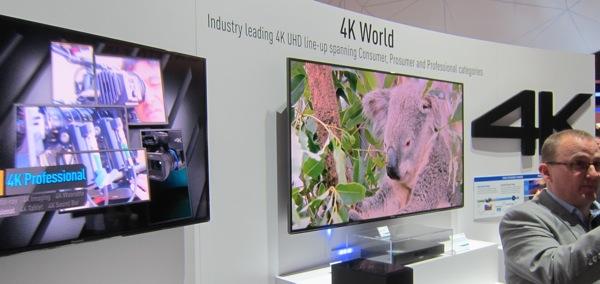Ultra HD's Brave New World: More Than Just 4K

While advanced color and HDR remain, for now, small players in the psychodrama that most folks still refer to as simply 4K, they’re definitely on their way. Wider color will offer at least the color you experience in a digital cinema, technically known as P3. We might even see the wider Rec.2020though the latter is unlikely to find its way into either UHD sources or UHD sets any time soon.
HDR is another new wrinkle, though as I write this there are only a few sets on the market that offer it (and compatible source material is similarly limited). Nor do they all adhere to the same HDR format. The compatibility of a Dolby Vision HDR source (one of the formats) with a set designed for HDR10 (another HDR formatand there are others as well), for example, is not fully known at present, at least publically.
Assuming that the HDR format issue gets settled, or is made to insure compatibility between sets and sources using dissimilar formats, the UHD retail landscape is still a bit of a minefield. If I were king, I’d mandate standard designations for a different range of capabilities. 4K would mean only 4K resolution. Ultra HD would mean 4K resolution plus advanced color. And UltraHD+HDR would mean the whole nine yards. But that’s not what we have now, so if you’re in the market for such a set, be sure to find out what you’re buying. We’ll try to help you with this in our reviews, but we can’t review all the sets on the market. So check it for yourself. And don’t necessarily rely on the salesman to set you straight. Even he or she might be confused. One thing you can be sure of is that the most full-featured UltraHD+HDR sets (even if they were so labeled, and they won’t be) will be limited to the top rung of a manufacturer’s lineup, at least for now.
Once you get that new set home, how do you get the best out of it? There’s a thriving industry out there of individuals or companies who will come to your house, test equipment in tow, and calibrate your set for the best picture possible—the Ubers of video if you will. The major organizations that train and certify such individuals are the ISF (Imaging Science Foundation) and THX. Yes, that THX. Even Best Buy has released the Geek Squad to join in on the fun. Calibration can be pricey however; $400 would not be an unusual charge, and it can go up from there. And the move to Ultra HD rumbles the calibration landscape. Different calibrations might well be needed both for today’s HD and the brave new world of 4K Ultra HD, complicating the work of calibrators and likely adding significantly to the cost.
This calibration business isn’t new, but may be new to some who read this blog. In fact, it has been around for over 20 years, beginning in the 480i SD era, moving on to standard HD, and now entering the less than settled realm of Ultra HD. (In a masterstroke of technobabble that’s guaranteed to confuse the masses, the industry has now coined the term “Full HD” to refer to 1080p HD, as contrasted with 4K Ultra HD. If you see a set referred to only as Full HD in the flyers that come with your Sunday paper, or on-line, or on the box the set comes in, you can be certain the set is notUltra HD.)
If you want your set to do everything it’s capable of, however, you’ll want a full, professional calibration. But since it won’t be cheap, your decision on having one will depend largely on your budget. If the set cost you less than $2000, or especially under $1000, it’s unlikely that a pro calibration will be money well spent. Apologies to the ISF and to THX, but that’s the way of the world. Fortunately, sets are getting better out of the box than they used to be, but there are still limits to how accurately the color can be dialed in on a mass production line. When you read the on-line versions of our reviews, you’ll see the settings we found optimum, not only for the standard controls but also for the color calibration. But you’ll also see a disclaimer stating that not every sample of a given model will work best with precisely these same settings. Your mileage may vary.
If you’re not planning on a full calibration, it’s at least important for you to learn how to properly set the standard video controls, including Brightness, Contrast, Backlight (on LCDs), Sharpness, Color, and Tint. This is the easiest part of any full calibration, and test DVDs and Blu-rays are available that make the process easy enough for even the most tech-phobic videophile. With a full calibration you’re paying the pro to dial in the color precisely using the set’s more advanced color controls. This is not a short or simple process and requires expensive test tools. But if you search our Help archives you’ll find more about the part of the setup you can do, and I’ll provide my take on how to proceed with it next time.
























































